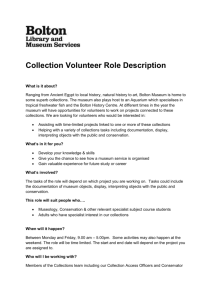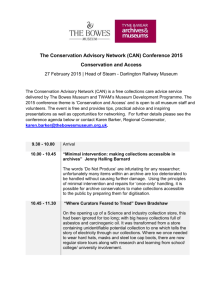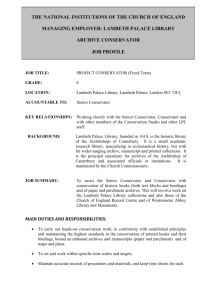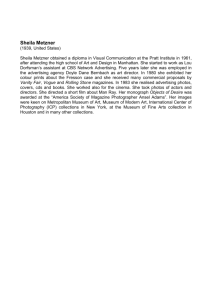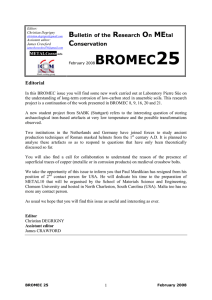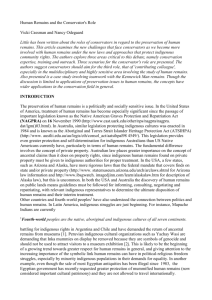Microsoft Word - grey-roots-summer-student-2014.doc
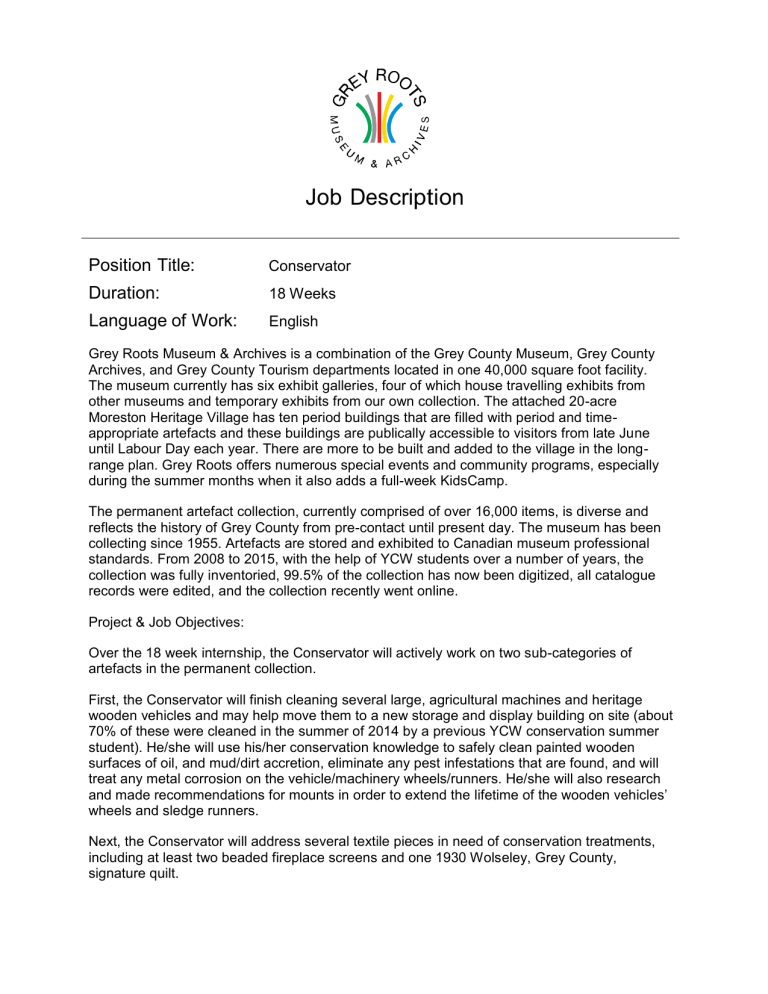
Job Description
Position Title:
Duration:
Conservator
18 Weeks
Language of Work: English
Grey Roots Museum & Archives is a combination of the Grey County Museum, Grey County
Archives, and Grey County Tourism departments located in one 40,000 square foot facility.
The museum currently has six exhibit galleries, four of which house travelling exhibits from other museums and temporary exhibits from our own collection. The attached 20-acre
Moreston Heritage Village has ten period buildings that are filled with period and timeappropriate artefacts and these buildings are publically accessible to visitors from late June until Labour Day each year. There are more to be built and added to the village in the longrange plan. Grey Roots offers numerous special events and community programs, especially during the summer months when it also adds a full-week KidsCamp.
The permanent artefact collection, currently comprised of over 16,000 items, is diverse and reflects the history of Grey County from pre-contact until present day. The museum has been collecting since 1955. Artefacts are stored and exhibited to Canadian museum professional standards. From 2008 to 2015, with the help of YCW students over a number of years, the collection was fully inventoried, 99.5% of the collection has now been digitized, all catalogue records were edited, and the collection recently went online.
Project & Job Objectives:
Over the 18 week internship, the Conservator will actively work on two sub-categories of artefacts in the permanent collection.
First, the Conservator will finish cleaning several large, agricultural machines and heritage wooden vehicles and may help move them to a new storage and display building on site (about
70% of these were cleaned in the summer of 2014 by a previous YCW conservation summer student). He/she will use his/her conservation knowledge to safely clean painted wooden surfaces of oil, and mud/dirt accretion, eliminate any pest infestations that are found, and will treat any metal corrosion on the vehicle/machinery wheels/runners. He/she will also research and made recommendations for mounts in order to extend the lifetime of the wooden vehicl es’ wheels and sledge runners.
Next, the Conservator will address several textile pieces in need of conservation treatments, including at least two beaded fireplace screens and one 1930 Wolseley, Grey County, signature quilt.
Measurable Outcomes:
Measurable outcomes include:
1. Number of identified wooden transportation collection items and large agricultural equipment pieces moved and cleaned (including three threshers, one brougham and one large wooden wagon);
2. Number of textile pieces stabilized so that they can be exhibited/handled without fear of further degradation/damage.
We expect to meet our goals by weekly updates on progress in each of the above outcomes.
Through close interaction and timely communication, progress will be monitored for potential challenges or roadblocks. All resources, tools and training will be provided to the student to complete his/her tasks. Success will be measured by using the above outcomes as indicators of what was accomplished and t o what extent. These will be the guidelines for the student’s end of season Developmental Appraisal.
Description of Tasks:
The Collections Conservation Assistant’s responsibilities will include:
1. Becoming familiar with the wooden transportation and large agricultural equipment collections and specifically the items that have been selected for exhibition in the new storage/display building. It is anticipated that the building, centering on the history of agriculture and early transportation in Grey County, will be open to the public in late June,
2016.
2. Give a final cleaning to all vehicles and equipment moved into the building. Addressing any damage and pest activity.
3. Researching and making recommendations for adequate wheel and runner support for any brittle or fragile pieces for 2016 conservation budgeting purposes.
4. Examining and writing treatment reports for at least two beaded fireplace screens and one heritage signature quilt. Conducting the conservation treatments on these pieces in order to stabilize them and make them display worthy.
Workplan:
Over the first week, the Conservator will be orientated to the policies and procedures of Grey
Roots Museum & Archives and the Collections Department and familiarized with the various buildings in which the artefacts are stored and the resources available to him/her, including the conservation lab. He/she will be trained in proper safety and emergency responses and on the collections management software (Past Perfect 5.0).
In December and January, under the guidance of the Collections Manager, the Conservator’s primary task will be to do a final cleaning on the wooden vehicles and large agricultural equipment. This may also include moving the sleighs and sledges from their current location, once there is snow on the ground and it is optimal to do so. The Conservator will ensure that
no moisture residue remains on any components.
All supplementary conservation treatments will be discussed, determined and approved by the
Collections Manager. The Conservator will record all work undertaken for each piece into the collections management database for future reference.
In February and March, the Conservator will examine the degradation and damage to at least two beaded fireplace screens and one Grey County heritage signature quilt. He/she will prepare treatments proposals for each, discuss them with the Collections Manager and then use his/her knowledge in order to stabilize and make them exhibitable. Currently the beaded pieces are unstable and cannot be handled because of thread breakage and the potential further loss of beading. The quilt, containing hundreds of names of Wolsley, Keppel Township,
Grey County citizens, needs extensive stabilization, as approximately 1/6 of its bottom was ragged and missing upon donation to the museum. The cause of this is unconfirmed, but is likely due to having been left wet and subsequently rotting at some point since its creation in
1930.
Candidate Profile:
This position will appeal to an individual with excellent written and verbal communication skills.
Preference will be given to candidates who have graduated from an accredited Canadian museum conservation program.
Candidates should be proficient in Microsoft Office and have a good vocabulary and above average writing skills. The candidate should exhibit patience, meticulousness and attention to detail and not be afraid to get their hands dirty. Familiarity with digital cameras and related software would be an asset, as would good hand-eye coordination. Experience working with artefacts, particularly in a museum or historic site is an asset. Candidates should be able to work both independently and as a team-player, be able to multi-task and problem-solve, and be highly organized and motivated.
We pride ourselves on helping co-op students and young people entering the workforce to become more aware of and interested in their local heritage and history in general. We will follow standard County interview and hiring procedures for this position and, as YCW terms dictate, ensure that the student, is a post-secondary graduate who has graduated within the past 24 months. The Corporation of the County of Grey is an equal-opportunity employer.

